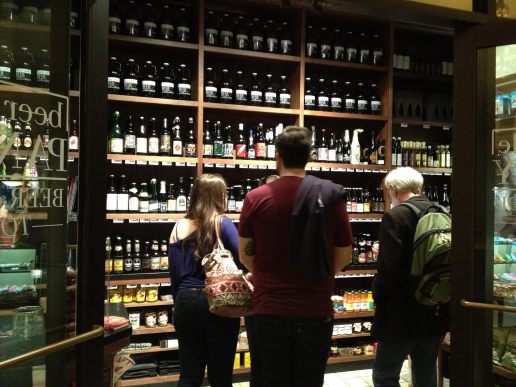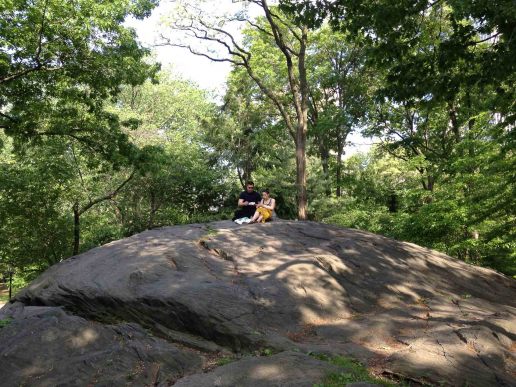[easy-social-share buttons=”facebook,twitter,pinterest,pocket,mail” counters=1 counter_pos=”hidden” total_counter_pos=”leftbig” style=”icon” twitter_user=”@Prostly” point_type=”simple”]
Before I started to drink beer, I started working in beer. Sometimes, as we all know, situation and circumstance mean that you find yourself learning as you go. Though lucky for me, turns out I stumbled upon my passion. The place I worked for at the time had a glass front fridge topped with empty and dusty bottles on display near the front door. A brag rack if you will. I knew right away that I was not cool enough. I hadn’t tried any of these beers but I knew inherently that they must be very special to be showcased in such a way. As I ran a damp cloth over each and every one of them I became fascinated. The salvaged bottles were carefully placed standing strong in rows like a broken down beer gang of worn out labels haggard from all the hard partying. I inspected each and every one of them, wanderlust-ing after the interesting places they hailed from. Surely, many sips and intelligent conversations were had speaking to their unique tasting notes and preparation. Where I worked it was common to come by brewers and beer aficionados on the daily. Then, I saw it, one lonely stubby aluminum can smack dab in the centre, dented and worn out bearing the fingerprints of many discovering it there and haphazardly sticking it back into its place.
Fast forward to when I’ve spent two years working actively in beer in Toronto and I’ve zipped over to New York on a ten hour overnight bus ride for a weekend away with buds. As I walked down the corridor leading out from the subway station I spot that very can attached to five more on a shelf in a specialty beer store. I immediately divorce it from its beer family and covet this lonely can after all of the years spent wondering after its importance. In my defence, it was 2008 at the time and the internet wasn’t where I was looking to decide what I wanted to try. Everything I had learned about beer was through self-research, asking questions and tasting and trying for myself – I owe a great deal of debt to the generosity of regulars who shared samples of their beers along the way to further my beer education and theirs. I paid ten dollars for this one can and made my way to Central Park. As I glanced out over the Jackie O’ reservoir I tried to relish that first sip as my attention swayed to that classic park hola-hooper who is always there (this one was topless just to add to the confusion of the sport, no judgements though). I try to fake it for a moment, but it’s bad. Pure stale sadness.

I’m from Ontario and our liquor laws are the pits, and this is why it’s even more exciting to travel and bring back yummy brews. If you love beer you know all too well how it feels to travel, discover and lavish over beers that are unavailable to you back home. I am not recommending that you ignore immigration, policies and fines that have been put into place. What I am trying to do is help avoid the sorrow of having brought back beer that simply doesn’t travel well.
Here’s a mini guide to the beers that travel well and how to pack them for the adventures ahead!
Buy cans or brown bottled beer and pay attention to best before dates. Reason being you are less likely to experience off flavours due to improper conditioning such as lightstruck/skunking, cardboard, sulfury/ yeasty*. In some instances, breweries will include a little symbol or message on the label recommending that you drink that style of beer fresh. Take heed!
Depending on your tastes, purchase bottle conditioned beers. These beers are in the process of second fermentation and are active and alive and can stand to hang out for longer periods of time.
Hop forward beers are delicious but generally speaking, hops have a shelf life. Hoppy beers are meant to be drunk fresh. Specialty shops can be goldmines but also sand pits for the inexperienced. There are currently no regulations for specialty shops so it can happen that you might readily find beers past their prime being sold for a premium.
Avoid novelty brews. If something touts having the highest IBU it might seem like a cool thing to spend your money on. That’s what I did about 6 years ago in England at Piccadilly Circus market. It wasn’t the most bitter shit I’ve tasted and I was the schmuck down more than a few Pounds in the end.
Be where you are. If you have travelled somewhere, drink the beer there and leave your phone in your pocket. Some of the best beer you will ever have are local and regional offerings. You have found yourself in a moment in time. I get that rating beer is a thing but you only have one life to live.
Socks! Wrap the brews in your socks and place them in your checked luggage. Be sure to buffer the sides of the case with extra clothes just to be safe. A hard case is optimal as bags can get chucked around at the airport. Temperatures on planes may vary but for the most part your beers can take the heat, just be sure to get them in the fridge as soon as you can.
Share your beers and travel stories with friends. We at Prostly know that beers are what bonds us from one continent to the next!
Safe Travels & Prost!
Ayns xo

*Light Struck/Skunking: when beers are exposed to direct sunlight or ultra violet light resulting in skunky (stinky skunk flavours), Mercaptan (butane-like, rotten flavours) and Sulfidic H2S flavours (rotten eggs, putrid). The ultraviolet light causes a reaction with the isomerize alpha acids from the hops. Avoid travelling with beers stored in green or clear glass bottles.
*Cardboard: when beers are stored at high temperatures or are excessively aged this can result in a myriad of off flavours ranging from wet paper and stale bread crumbs to leathery, woodsy and sherry-like flavours.
*Sulfury/Yeasty: yeast autolysis occurs when the yeast in the beer essentially dies of old age. Avoid drinking beers kept past their prime.
Sign-up for our Monthly Newsletter
3 Comments
Add comment Cancel reply
This site uses Akismet to reduce spam. Learn how your comment data is processed.


[…] Bagging Beers: A Guide for Buying Beers on Your Travels […]
Like the sock wrapping idea
I like the pictures of you and that nice young man you are with! Nicely written – fun and knowledgeable.